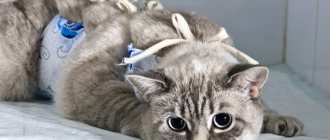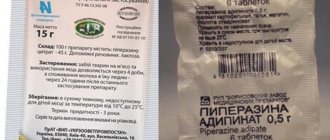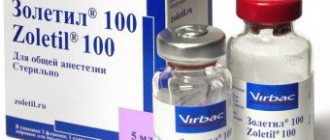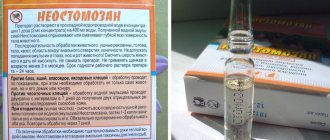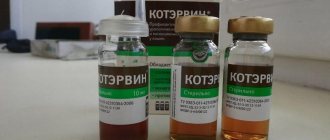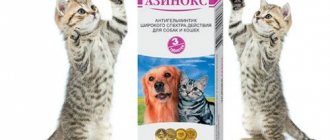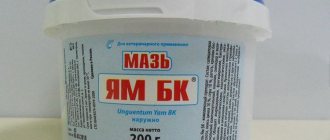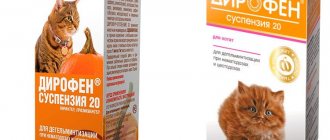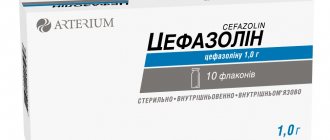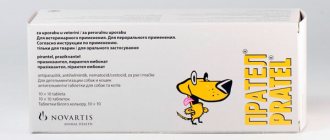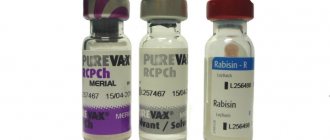Cycloferon for cats is used quite often in veterinary practice. It allows you to replenish the animal’s interferon deficiency when the body’s natural defenses are weakened due to viral infections.
The substances in the drug activate the immune system, quickly increasing the amount of protective proteins in the blood. Initially, the drug was registered as a veterinary drug, and after 2 years it began to be used for humans.
You can purchase the medicine at a veterinary pharmacy or a regular one.
Description of the drug Cycloferon
The medicine has been used in medical and veterinary practice for more than 20 years. The main active ingredient is meglumine acridone acetate. It stimulates the body's production of interferon, eliminates inflammation, and fights the virus.
Cycloferon is prescribed for cat flu, hepatitis, calcivirosis, rhinochlameide and many other viral infections. Additional substances in the medicine contain calcium stearate, benzalkonium chloride, methylcellulose, povidone, etc.
Features of use for various pathologies
The drug is used in tablets or injections for respiratory infections such as cat flu.
Veterinarians prescribe Cycloferon for cats in tablets and injections for such pathological conditions as:
- infection of the upper respiratory tract and oral cavity;
- acute respiratory infections, including rhinitis, influenza, laryngotracheitis;
- a pathological process characterized by the formation of papillomas on the skin and mucous membrane;
- an infectious disease caused by chlamydia and sexually transmitted;
- feline distemper;
- viral infections of the digestive system.
For kittens and large females, veterinarians prescribe the ointment when the animal is injured or has undergone surgery. Liniment effectively stops inflammatory processes, accelerates tissue healing, minimizes the risk of developing tumors and prevents the occurrence of fungus. Cycloferon interacts well with other symptomatic medications, and together with antibiotics and interferon even enhances their therapeutic activity.
Composition and release form
The drug is available in 3 forms:
- Injection. A clear liquid that can be administered intravenously or intramuscularly. The package contains 5 ampoules - enough for a standard course of treatment.
- Pills. Sold in cardboard boxes of 10 or 20 pcs. Each pill contains 150 mg of meglumine acridone acetate. Dissolves in the intestines.
- Yellow ointment for external use. Tube volume: 30 ml. Contains 5% of the main active ingredient.
The choice of form depends on the nature of the disease, the severity of its course and the individual tolerance of the drugs to the animal.
Price and analogues
The cost of Cycloferon is quite high. Tablets have the following average price: 10 pcs. – 180-210 rub., 20 pcs. – 350-410 rub., 50 pcs. – 800-900 rub. 5 ampoules per package cost from 350 to 400 rubles. The price of the ointment also depends on the volume of the drug: 5 ml – 120-150 rubles, 30 ml – 400-450 rubles.
There are other drugs for cats that have a similar effect to cycloferon, but they are not its complete analogues:
- Roncoleukin is a very powerful immunostimulant in the form of a solution. Used for diseases caused by fungi, viruses, bacteria. Administered intravenously.
- Fosprenil - used to treat viral diseases. The drug is available in the form of a solution, stimulates the immune system, and increases the body's resistance to infection. Fosprenil is injected subcutaneously, into a muscle, into a vein, and sometimes it is taken orally.
- Neoferon - available in tablets and solution. It has a beneficial effect on the growth of intestinal microflora, relieves inflammation, and stimulates the cat’s immune system.
- Kinoron is a white powder. It is dissolved in distilled water or saline and injected subcutaneously or into the muscle. Kinoron stimulates the immune system and increases the body's resistance to viruses.
- Gamaprene – designed to speed up the recovery of cats. Available in the form of a yellowish transparent liquid. The product is administered to animals orally.
- Gala-vet is available in powder form, which is diluted in water for injection and injected into the muscle. The drug stimulates the immune system and increases the activity of leukocytes.
It is better to consult a veterinarian before use. He will assess the animal’s condition and prescribe a suitable treatment regimen.
The principle of action of interferons
Along with the antiviral, the drug has an anti-inflammatory effect, inhibits the development of tumors by suppressing the growth of atypical cells, and promotes the restoration of damaged tissues.
When ingested, it has the following effects:
- provokes the production of interferon in the tonsils, liver, spleen, and intestines;
- triggers the production of granulocytes - white blood cells that block inflammation;
- increases the rate of stem cell maturation;
- eliminates disorders in the immune system and activates the body's resources;
- improves metabolism and stops the growth of malignant cells.
Storage rules
The solution is stored at a temperature no higher than 25 degrees and no lower than 0 degrees (for ointment, the minimum permissible storage temperature is 10 degrees). Tablets and liniment retain their medicinal properties for 2 years, solution in ampoules - 3 years.
Regarding storage, there is one main rule: hide it from children and animals. In addition, it is not recommended to leave the drug in places where it will be exposed to direct sunlight. Regarding storage, you should also take into account the form in which the drug was prescribed to your animal.
Indications and contraindications for use
Veterinarians prescribe injections and tablets to animals for the following diseases:
- infections of the lungs, bronchi, and oral cavity;
- respiratory diseases, incl. laryngotracheitis, influenza, respiratory infections, bronchitis with difficulty breathing;
- plague;
- intestinal infections of viral etymology;
- hepatitis in acute and acute chronic stages;
- autoimmune diseases;
- tick-borne encephalitis, skin infections after bites.
The ointment is used when it is necessary to accelerate the healing of wounds, burns, and postoperative scars. To prevent secondary infection and fungal damage, it is combined with an antibiotic.
Full details of contraindications can be found in the instructions for the drug. Before use, you should consult your veterinarian, as... Not all cats can be given the medicine.
Contraindications to the use of Cycloferon to treat cats are:
- weakened and unstable mental state of the pet;
- previously occurred allergic reactions to the components of the drug;
- severe diseases of the liver and digestive system.
Side effects that may occur with long-term use of the medicine or exceeding the recommended dosage:
- drowsiness, weakness, slow reaction to external stimuli;
- itching at the injection site of the liquid form of the drug;
- skin rashes, local allergic reaction;
- chills, fever;
- tremor in paws.
When to use this medicine
The drug is recommended for the treatment of cats diagnosed with:
- flu;
- enteritis;
- feline distemper;
- acute respiratory diseases.
Solutions are prescribed for inclusion in complex therapy of secondary immunodeficiencies that have developed against the background of acute and chronic bacterial and fungal infections, rheumatic, degenerative pathologies (arthritis, lupus, osteoarthritis, etc.).
The indication for injections is viral hepatitis. Liniment is used for herpes and chronic periodontitis. The external remedy is also prescribed as an anti-inflammatory and wound-healing medicine.
Analogues of the drug
There is no complete analogue of Cycloferon, so it is not worth canceling treatment with this drug prescribed by your veterinarian unless necessary. It is recommended to replace it with other antiviral and immunostimulating agents only if symptoms of intolerance to meglumine acridone acetate or other substances from the composition appear.
Table: comparison of drugs that can replace Cycloferon
| Name | Release form and indications | The main substance in the composition | Contraindications | approximate price |
| Azoxyvet | Solution for the treatment of infectious diseases of any etiology | Azoximer bromide |
| 124 rub. |
| Interferon | Solution for the treatment of viral diseases, strengthening the immune system | Interferon |
| 284 rub. |
| Feliferon | Solution for injections for diseases of viral or mixed etiology | Interferon |
| 330 rub. |
| Gamaprene | Solution for the treatment of viral respiratory infections | Polyprenols phosphate salts |
| 460 rub. |
| Glycopene | Tablets for the treatment of viral infections | Glucosaminylmuramyl dipeptide |
| 225 rub. |
Photo gallery: Cycloferon analogues for cats
The use of Azoxyvet in complex therapy can increase the effectiveness and reduce the duration of treatment, significantly reduce the use of antibiotics
Gamapren is an innovative immunomodulator that was developed specifically to eliminate the symptoms of herpes virus infection in cats.
Interferon is a protein molecule that provides antiviral immunity
Feliferon is an immunomodulator, which is available in the form of an injection solution
Glycopene is a safe regulator of the immune system of pets
Instructions and dosage
The injection solution is considered the most potent form. It is necessary to calculate the dosage according to the weight of the animal to reduce the risk of side effects.
For weights up to 2 kg, the drug is used in a dose of 0.5 ml. For larger pets - 1 ml. Opened ampoules cannot be stored. At home, it is better to inject the medicine intramuscularly (into the thigh) or subcutaneously on the 1st and 2nd days of the disease, then every other day. The course of treatment is 8 days.
The tablets are crushed and mixed with food or your cat's favorite treat to prevent vomiting. It is permissible to dilute with water and pour in using a pipette. Dosage regimen: 1/2 a day for a week. After this, it is necessary to assess the pet’s condition and decide on further actions.
The ointment is applied to the affected parts of the body in a thin layer, carefully spreading the hair. Once on warm skin, it is quickly absorbed, so no bandage or patch is used. A veterinary collar is worn if the animal licks the liniment after application. Apply for 5 days, 2 times a day.
Cycloferon for genital herpes
In addition to systemic therapy, applications with Cycloferon liniment are used:
- a thin layer of the product is applied to the affected areas daily for 5–7 days;
- use the drug for intravaginal or transurethral instillation, injecting 5 ml daily for 2 weeks;
- cotton swabs soaked in ointment are inserted into the vagina for 10–15 days.
Cycloferon ointment can be alternated with the use of other topical drugs.
Methods of application
Dosage
The drug is dosed based on the weight of the animal.
In injection form:
- <1kg – 0.8ml/kg
- 2kg – 0.4ml/kg
- 2-5kg – 0.2ml/kg
- 6-12kg – 0.15ml/kg
- 13-25kg – 0.12ml/kg
- 26-40kg – 0.1ml/kg
- Over 40kg – 0.08ml/kg
In tablet form:
- <1kg – injection form is recommended due to the difficulty of dividing the tablet.
- 1-3kg – 37.5 mg active ingredient (1/4t.)
- 4-6kg – 75mg a.v. (1/2 t.)
- 7-10kg – 112.5 mg (3/4t.)
Important! The drug is used in a course. The duration of the course is determined by a veterinary specialist.
Scheme
Dosage regimen: 1st, 2nd, 4th, 6th, 8th, 11th, 14th, 17th, 20th, 23rd day of illness.
The minimum course is at least 8 days.
In the form of liniment, the drug is used externally: 1-2 times a day in a course, for 5 – 10 days. Application is carried out evenly, the layer of the substance should be thin.
Side effects and contraindications
When using the drug, a number of side effects are possible:
- temporary lethargy;
- urge to vomit;
- dyspeptic symptoms;
- when applied topically - a short-term burning sensation, hyperemia of the application site.
Contraindications:
- the main contraindication is the presence of an allergic response of the body to one of the components of the drug;
- the use of the drug in pregnant and lactating animals is unacceptable;
- severe liver disease (cirrhosis);
- inflammatory diseases of the gastrointestinal tract in the acute stage
Interaction with other drugs: cycloferon can be combined with other pharmacological agents (antibiotics, antiviral and antifungal drugs, vitamins, immunostimulants)
What can be replaced
Cycloferon has no analogues identical in composition.
In case of urgent need for replacement, when individual intolerance to the components is observed, the following medications can be used:
- Azoxyvet. The solution is used for infections.
- Interferon. An antiviral agent that simultaneously enhances immunity.
- Gamaprene. The injections are used to treat respiratory viruses.
- Glycopene. Sold in tablet form. Effective against various viral infections.
How does Cycloferon act on a cat?
In tablet form, the drug begins to act after 10–15 minutes, reaching maximum concentration after 2 hours. When the solution is administered, the active substances begin to fight viruses earlier - 2-5 minutes after the injection. The half-life of the drug is 4–5 hours (typical for all forms of the drug).
The action of Cycloferon is based on stimulating the body to more intense production of lysozyme, lipoperoxidase and other antibiotic proteins that affect viral and bacterial infections. A noticeable improvement in the condition of the sick animal is observed from the first day. With a properly designed treatment program, complete recovery occurs in 10–15 days (depending on the stage and form of the disease).
Reviews
ZooDoc. We took a kitten into the house, and he infected our adult cat with a viral infection. The cats were prescribed complex treatment, one of the components of which was cycloferon.
After a couple of weeks, both animals were healthy.
Krooolcha. In our nursery, a viral infection has massively affected the adult population of cats and a few kittens. Everyone had the same symptoms. He was treated according to a comprehensive scheme. Cycloferon was used as an immunostimulant. Used according to instructions until day 10. No side effects were observed in any animal.
Eleven Pride . Cycloferon is convenient and easy to use, works great for viral infections, and is good for inflammatory reactions. Plus, it’s safe – with virtually no side effects or contraindications. The most important thing is to strictly follow what is written in the instructions for use.
Characteristics of the drug
In 1993, cycloferon was registered as a veterinary drug. Only two years later, it began to be used to treat people. Today you can buy this medicine in regular and veterinary pharmacies.
Cycloferon has almost no side effects.
It acts gently and additionally restores mucosal cells at the site of infection by the virus (when used topically). Has a minimum of side effects. At the same time, it is quite effective. And in combination with other immunostimulants and antibiotics, it can quickly cure a cat from a viral infection and prevent complications - this is written in the instructions for use.
A large amount of the product accumulates in lymphoid tissue. It stimulates the production of granulocytes and increases the body's own defenses. The drug is non-toxic and does not cause systemic poisoning.
Under what conditions should the drug not be used?
The instructions for this product indicate cases when it is better to avoid using the drug. This is the cat’s excessive sensitivity to the main active ingredient and significant weight loss or a general depressed state of the animal. Cycloferon is also prescribed with caution for cats if allergic manifestations have previously been observed in animals.
This is due to the fact that one of the side effects is allergic reactions. However, this happens quite rarely in cats.
If such manifestations are nevertheless detected, you should immediately inform your veterinarian and replace Cycloferon with another drug. Also, cat owners should remember that with pronounced viremia, four to eight hours after the injection, the animals may develop a fever, and in rare cases, violet fluorescence may be observed in the urine. Therefore, you should give Cycloferon to your cat carefully, strictly following the instructions.
Characteristics of Cycloferon
The main active substance of the drug is acridone acetic acid. Calcium stearate and methylcellulose are auxiliary.
This antiviral drug is available in several forms: tablets, solution, liniment. The first is brown pills. The solution is available in ampoules of 2 ml, it is transparent, and 1 ml of the medicine contains 125 mg of the main substance. Liniment 5% is a yellow gel in a tube.
Cycloferon is an antiviral and immunomodulatory drug. This is a high-molecular inducer of the formation of endogenous interferon. In the body of cats, the medicine exhibits biological activity, has antitumor, antiproliferative, and anti-inflammatory effects. After its administration, a large number of interferons appear in tissues with lymphoid elements (liver, lungs, spleen). Under the influence of Cycloferon, bone marrow stem cells are activated. Granulocytes are actively produced. The drug provides a pronounced correction of the immune status, which, in turn, forces the animal’s body to mobilize its own forces to fight foreign agents. The drug normalizes metabolic processes.
Cycloferon ointment produces a local anti-inflammatory effect. It has a regenerating effect on mucous membranes, damaged and injured tissues.
After administration of the drug in the form of a solution and consumption of tablets, its maximum concentration in the blood is observed after 2-4 hours. The half-life of the drug is 4-5 hours. The drug is excreted from the body of pets by the kidneys. Its active substance does not accumulate in the animal’s body when used in recommended doses.
The high biological activity of Cycloferon is combined with its low toxicity.
Contraindications
The instructions warn about restrictions in the use of antiviral medicine. This is high sensitivity to the main active substance, severe weakening of the animal, its exhausted state. Cycloferon is used with caution for those animals that have a history of allergic reactions.
Side effects of the drug manifest themselves in the form of allergies. But, as a rule, such effects develop very rarely. If they occur, then this must be reported to the veterinarian. The instructions also warn that in case of severe viremia after administration of the drug, the temperature may increase in 4-8 hours in cats and kittens. Sometimes purple fluorescence of urine may be observed.
Reviews from owners and veterinarians about the drug
According to doctors and specialists, cycloferon helps to cope with diseases along with taking vitamins and other methods to strengthen the immune system.
Veterinarians give positive reviews about the product. It allows you to quickly increase the level of interferons in the cat’s blood with minimal risk of side effects.
Owners are often dissatisfied with the prescription of the drug due to its high cost. There is an opinion that analogues give the same effect, but are more affordable.
Reviews of the drug from cat owners
Cat owners often leave reviews about this drug as an effective treatment for viral infections in cats.
Cat owners speak positively about the drug Cycloferon.
Tatiana. We didn’t have time to vaccinate the kitten, and he ended up getting calcivirus. The veterinarian did not give any prognosis, but prescribed cycloferon with the hope that it would help. The cat recovered within a few days, and after a week and a half returned to normal life. He is now one and a half years old and has no health problems. I'm glad that this drug helped save my pet's life.
Igor. I never thought that cats got colds until our Burmilla cat Ray started sneezing. They took him to the clinic, where he was diagnosed with a respiratory infection. The cat was injected with cycloferon according to the regimen prescribed by the doctor. On the second day the animal began to eat, and a week later it completely recovered.
Pets are no less susceptible to viral diseases than their owners. Therefore, you should be prepared for the fact that the animal’s condition may worsen and be aware of medications with antiviral effects. One of them is Cycloferon. Let's take a closer look at its composition, pharmacological action, contraindications and method of use for cats.
In what cases is the drug prescribed to cats?
The basis for treating animals with Cycloferon are identified viral enteritis and hepatitis, carnivore distemper, laryngotracheitis, manifestations of influenza and acute respiratory infections. This medicine is also prescribed for cats if rhinotracheitis, panleukopenia, calcivirosis, and chlamydia are detected in the animal.
The ointment is recommended in cases of injury to the animal or after surgical operations in cats. It helps stop inflammatory processes and has a regenerating effect on the cat’s body. It is also used in the treatment of demodicosis, the occurrence of fungus and the appearance of neoplasms.
Cycloferon for cats interacts well with other symptomatic medications. When used with interferon or antibiotics, this drug can significantly enhance their effect.
Cycloferon can be administered subcutaneously or intramuscularly to cats. If the pet has an acute phase of the disease, the cat is prescribed to inject Cycloferon intravenously, it is combined with serums, globulins and interferon.
For cats, the dosage of Cycloferon varies depending on the weight of the pet:
- 0.80 ml of solution is taken per 1 kg of weight;
- for 1-2 kg - 0.40 ml;
- for 2-5 kg - 0.20 ml;
- for 6-12 kg - 0.15 ml;
- for 13-25 kg - 0.12 ml;
- 26-40 kg - 0.10 ml;
- more than 40 kg - 0.08 ml.
Before using the medicine, you must carefully read the instructions, paying attention to how the drug should be used for kittens, as well as how much Cycloferon tablet contains the active substance.
Cycloferon may have side effects. It happens that the animal’s body temperature rises, and with a significant concentration of harmful viruses in the blood, purple fluorescence may appear in the urine.
Possible restrictions and adverse reactions
You cannot inject (drink or apply) Cycloferon to cats with individual intolerance to any component of its composition. Antiviral medicine is contraindicated for an exhausted, weakened animal and for those with a history of allergic reactions. Cycloferon is often well tolerated, but in exceptional cases, during treatment with it, cats develop an allergy. If undesirable effects are observed, the breeder needs to stop the therapy and take the pet to the veterinarian. In addition, sometimes there may be a change in the color of urine.
Contraindications and side effects
The drug should not be used if the animal is too exhausted and weakened.
Side effects occur rarely, mainly in animals prone to allergies. It manifests itself in the form of a rash, redness and itching of the skin.
With a highly progressive infection, after the administration of cycloferon, the temperature may rise - this is a natural reaction to the activation of the immune system. In rare cases, a cat's urine may turn purple. This is due to excessive stress on the kidneys. It is better to consult a veterinarian about this.
Who is at risk?
Those at risk most likely to develop purple urine are:
- women. Due to the specific location of the genitourinary system, women have an increased risk of contracting infections. This leads to a change in the color of urine;
- patients with long-term catheterization of the urinary system. Infection in this case is quite common, but the urine that appears is purple in color and is not yet an indicator of pathology. Typically, the affected organ must be treated for infections;
- people with kidney failure or frequent constipation. In the presence of such problems, the patient has a fairly common occurrence of periodic or regular appearance of purple urine.
In most cases, purple urine occurs in older people who have weakened immunity. The change in color is accepted as a temporary phenomenon that does not entail serious complications.
But in some cases, an unusual color of urine can signal problems in the body or a serious illness. As soon as urine of an unusual color is detected, you should contact a specialist as soon as possible, get a treatment plan and take the required tests.
How long do traces of drugs last in urine?
7:21 Heading How long do traces of drugs last...8:59 Heading 7 Things Your Urine Can Ra...25:50 Heading Urine analysis and urinary tract infections... Author rating Author of the article Anatoly Shishigin Articles written 210
Instructions for use of Cycloferon for cats
Many pets are exposed to viral diseases. It is necessary to take into account that the pet’s condition may worsen. In order to provide timely assistance to a sick pet, it is necessary to have an effective drug in your home veterinary medicine cabinet - Cycloferon for cats. To use the medicine correctly, you need to know the principle of its effect on the animal’s body, contraindications and dosage.
The main active component of the drug is acridone acetic acid. The drug contains the following substances as additional components:
This drug belongs to the category of immunomodulatory agents with antiviral effects. Cycloferon serves for the rapid formation of interferon. The drug exhibits bioactivity in the body of cats and has anti-inflammatory, antiproliferative and antitumor effects on the body. Cycloferon is an inducer of the formation of endogenous interferons in lymphoid organs (spleen, lungs, tonsils, etc.). Cycloferon also affects the bone marrow: under its influence, the production of granulocytes is significantly activated.
Thus, this drug mobilizes the body's defenses and ensures the proper level of metabolism to fight infection.
In veterinary pharmacies, Cycloferon for cats is presented in three forms:
- liniment 5% – is a yellowish substance enclosed in a tube;
- solution - distributed in glass ampoules with a volume of 2 ml. 1 ml contains 125 mg of active substance;
- tablets are small in size and brown in color.
Gel (ointment) is intended for topical use.
According to the instructions for this product, the use of this drug is contraindicated in case of individual intolerance to the components of the product and in a state of exhaustion of the animal.
Side effects are quite rare and represent allergic manifestations.
If such a reaction occurs in your pet, you should stop taking the medication and consult a veterinarian.
You cannot ignore the warning of specialists about an increase in the cat’s temperature with pronounced viremia. This effect can be observed only after 5-8 hours after an injection, taking a tablet or smearing with gel.
Sometimes, after administration of the drug, fluorescence (glow) of urine is observed in a purple color.
The drug is used for the spread of viral hepatitis or enteritis, canine distemper, influenza, laryngotracheitis, and respiratory ailments. It is also used for diseases of cats and cats with panleukopenia, chlamydia, rhinotracheitis, and calcivirosis.
The solution of Cycloferon and its tablets are perfectly combined with other symptomatic drugs. By combining the drug with antibiotics, interferon and other similar substances, their effects can be prolonged and greatly enhanced.
For pets, the solution is prescribed intramuscularly or under the skin. In particularly acute cases, it is combined with interferon, globulins, serums and injected directly into a vein.
The dosage of the medicine is carried out in accordance with the pet’s body weight. The dose for kittens and adult animals is selected according to the following scheme.
What's in Cycloferon?
The main active component of this drug is acridoneacetic acid, and the excipients are methylcellulose and calcium stearate.
Cycloferon for cats is produced in three forms: in tablet form (brown pills), in the form of liniment (yellow ointment), and also in the form of a colorless solution for injection (2 ml ampoules). It is used as an immunomodulatory and antiviral agent. Cycloferon is a high-molecular inducer of the formation of endogenous interferon.
Once in the cat’s blood, the components of the drug become biologically active. Cycloferon has antitumor and antiproliferative properties. Cycloferon for cats helps cope with the anti-inflammatory effect. After the injection, the number of interferons in tissues with lymphoid elements (spleen, lungs, liver) increases noticeably.
This remedy for cats also activates bone marrow stem cells. Granulocytes begin to be rapidly produced.
Under the influence of the medicine, the status of the immune system is noticeably corrected, which has received a powerful incentive to mobilize internal resources to fight foreign harmful bacteria. Cycloferon has a beneficial effect on normalizing metabolism.
It is found on pharmacy shelves in the form of an ointment and is intended for external use. Cycloferon promotes the regeneration of mucous membranes and damaged upper tissues . It is also possible to use Cycloferon for viral diseases of pets.
The peak concentration of Cycloferon in the cat’s blood is observed two to four hours after the injection or taking the tablet. A significant part of the drug is excreted from the body in four to five hours along with urine; if the dosage is observed, it practically does not accumulate in the body. High biological activity is well complemented by its low toxicity.
